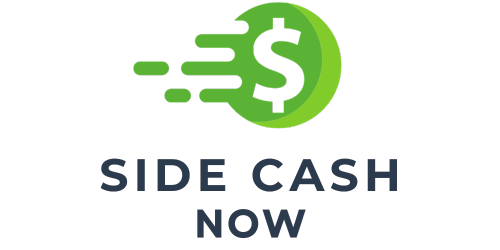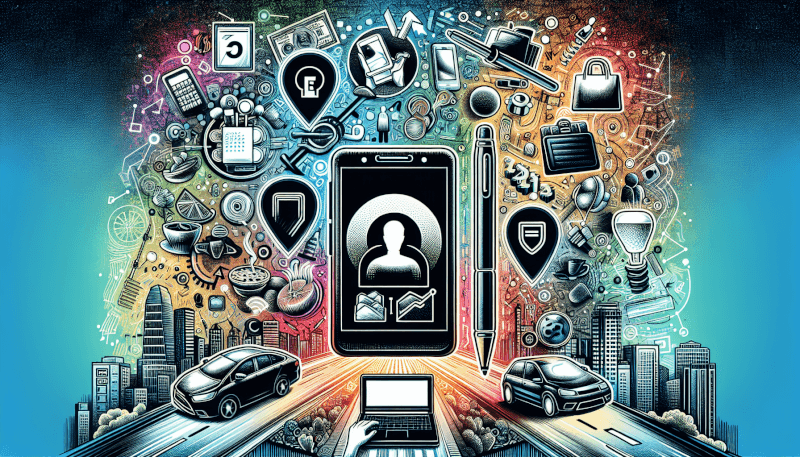Have you ever wondered how people are making extra money on the side while juggling their full-time jobs? In the ever-evolving gig economy, individuals are finding innovative ways to monetize their skills and hobbies. From freelancing to ride-sharing, the possibilities are endless. In this article, we will explore the world of side hustles in the gig economy and discover how you can tap into this growing trend to boost your income and pursue your passions.

What is the Gig Economy?
The gig economy refers to a labor market characterized by the prevalence of short-term, flexible, and freelance work arrangements. In this economy, individuals take on side hustles or gigs outside of their traditional full-time employment to earn extra income or pursue their passions. The gig economy has gained significant traction in recent years, fueled by advances in technology and a shift in work preferences among individuals seeking greater flexibility and autonomy in their careers.
Definition
The gig economy can be defined as a labor market consisting of part-time, contract, or freelance work arrangements, typically facilitated through digital platforms and apps. It allows individuals to offer their services or talents on a project basis, without the need for long-term commitments or traditional employment contracts. The gig economy encompasses a wide range of side hustles, from driving for ride-sharing services to offering professional skills through freelancing websites.
Characteristics
The gig economy is characterized by several key features. First and foremost, it offers individuals the freedom to choose when, where, and how they work. Instead of being tied down to a traditional 9-to-5 job, gig workers can set their own schedules and take on projects that align with their personal preferences and availability.
Another characteristic of the gig economy is the use of digital platforms and apps to connect gig workers with potential clients or customers. These platforms serve as intermediaries, providing a convenient way for individuals to find side hustles and for businesses or individuals to outsource tasks or projects. The digital nature of the gig economy also enables gig workers to work remotely and offer their services to clients worldwide.
Additionally, the gig economy often fosters a sense of entrepreneurship among gig workers, as they are responsible for marketing themselves, managing their own finances, and building their professional networks. This entrepreneurial mindset can lead to opportunities for skill development and personal growth, as individuals take on a variety of projects that allow them to expand their expertise and explore different industries or areas of interest.
Types of Side Hustles
Ride-Sharing
One of the most popular side hustles in the gig economy is ride-sharing. Platforms like Uber and Lyft enable individuals with a car and a valid driver’s license to pick up passengers and earn income by providing transportation services. This type of side hustle offers flexibility in terms of working hours and provides an opportunity to interact with different people from varied backgrounds.
Delivery Services
Another common type of side hustle in the gig economy is delivering goods and services. Companies like DoorDash and Instacart connect gig workers with individuals or businesses who need groceries, meals, or other items delivered to their doorsteps. This side hustle is particularly appealing to those who enjoy driving and want to make use of their time efficiently.
Freelancing
Freelancing is another popular avenue in the world of side hustles. Freelancers offer their specialized skills and services on a project basis, such as graphic design, writing, programming, or consulting. Platforms like Upwork and Fiverr connect freelancers with clients, allowing them to showcase their expertise and find work opportunities that align with their interests and abilities.
Renting Assets
Renting out assets is a lucrative side hustle option that allows individuals to monetize assets they own but do not use regularly. For example, renting out spare rooms or properties through platforms like Airbnb or VRBO can generate a significant stream of income. Similarly, renting out equipment or even personal items like cameras or tools can provide an additional source of earnings.
Task-Based Platforms
Task-based platforms like TaskRabbit or Gigwalk enable individuals to perform a wide range of odd jobs or tasks for others. These can include anything from assembling furniture to running errands or participating in market research. Task-based platforms offer a wide variety of options and allow individuals to select tasks based on their preferences and capabilities.
Advantages of Side Hustles in the Gig Economy
Flexibility
One of the primary advantages of side hustles in the gig economy is the flexibility they offer. Unlike traditional employment, side hustles allow you to choose when and where you work. This flexibility is particularly valuable for those who have other commitments, such as childcare or pursuing higher education. Side hustles enable you to tailor your work schedule to fit your lifestyle, allowing for a better work-life balance.
Extra Income
Side hustles are an excellent way to supplement your primary source of income. Whether you are saving for a big purchase, paying off debts, or simply looking to boost your disposable income, a side hustle can provide the additional financial support you need. The beauty of side hustles is that they can be done on a part-time basis, allowing you to earn extra income without the need for a significant time commitment.
Skill Development
Engaging in side hustles provides an opportunity to develop and refine your skills. Whether you are working as a freelancer, offering a specialized service, or providing transportation or delivery services, side hustles allow you to gain practical experience and expand your skill set. This can be particularly valuable if you are looking to transition into a new career or enhance your marketability in your current field.
Networking Opportunities
Side hustles often involve interacting with a wide range of people, including clients, customers, and fellow gig workers. These interactions can serve as valuable networking opportunities, as they may lead to connections with individuals who can offer further career prospects or collaborations. Building a strong professional network through your side hustle can open doors to new opportunities and expand your horizons.
Challenges of Side Hustles in the Gig Economy
Income Volatility
One significant challenge of side hustles in the gig economy is the inherent income volatility. Since side hustles typically involve working on a project-to-project basis or on-demand, there may be fluctuations in income from month to month. This unpredictability can make it challenging to budget and manage personal finances effectively, requiring individuals to plan and save accordingly.
Lack of Benefits
Unlike traditional employment, side hustles in the gig economy often do not come with benefits such as health insurance, retirement plans, or paid time off. Gig workers are typically responsible for sourcing and paying for their own benefits, which can add to their financial burden. It is essential for individuals engaged in side hustles to carefully consider the costs and implications of not having access to traditional employment benefits.
Uncertain Workload
Another challenge of side hustles is the uncertainty of workload. While some months may be busy with a steady stream of projects, there may be periods of lulls where work becomes scarce. This inconsistency in workload can make it difficult to plan ahead and manage time effectively. Gig workers need to be prepared for fluctuations in their workload and have contingency plans in place to tide over lean periods.
Competition
The gig economy is highly competitive, with many individuals vying for the same projects or gigs. This competitive landscape can make it challenging to stand out and secure consistent work opportunities. To succeed in the gig economy, it is crucial to build a strong professional brand, continuously update your skills, and actively seek out new clients or customers. Adapting to changing market trends and staying ahead of the competition is essential for sustained success.

Tips for Success in Side Hustles
Identify Your Skills and Interests
When embarking on a side hustle, it is important to identify your skills and interests. Assess your strengths, talents, and areas of expertise to determine what type of side hustle aligns with your abilities and what you enjoy doing. By focusing on activities that leverage your skills and passions, you are more likely to find fulfillment and success in your side hustle endeavors.
Research the Market
Before diving into a side hustle, take the time to research the market and understand the demand for your chosen gig. Analyze the competition, identify target markets or customers, and gauge the potential for growth or profitability. By conducting thorough market research, you can tailor your side hustle offerings to meet the needs and preferences of your target audience, increasing your chances of securing projects or customers.
Build a Strong Online Presence
In today’s digital age, having a strong online presence is crucial for success in the gig economy. Establish a professional website or create profiles on relevant platforms or social media channels where potential clients or customers can find you. Showcase your skills, previous work, and client testimonials to build credibility and attract new opportunities. Regularly update your online presence to stay relevant and visible to your target audience.
Set Realistic Goals
Setting realistic goals is essential for managing your side hustle effectively. Determine what you hope to achieve through your side hustle, whether it be earning a specific amount of income, acquiring new skills, or expanding your professional network. Break down your goals into actionable steps and create a timeline to track your progress. By setting achievable goals, you can stay focused and motivated as you work towards building a successful side hustle.
Manage Time Effectively
Time management is critical when juggling a side hustle alongside other commitments. Establish a schedule that allows you to dedicate sufficient time and energy to your side hustle without neglecting your primary responsibilities. Prioritize tasks, eliminate time-wasting activities, and leverage productivity tools or techniques to stay organized and maximize your efficiency. Effective time management will ensure that you can meet deadlines, exceed client expectations, and maintain a healthy work-life balance.
Network and Collaborate
Networking and collaboration are key strategies for success in the gig economy. Engage with fellow gig workers, attend industry events or conferences, and join online communities or forums relevant to your field. Actively seek out opportunities for collaboration or partnership, as working together with others can lead to new projects, referrals, and expanded skillsets. By building a strong network and fostering mutually beneficial relationships, you can enhance your visibility and open doors to new opportunities.
Side Hustles and Financial Independence
Diverse Income Streams
One of the significant benefits of side hustles in the gig economy is the potential to create diverse income streams. By engaging in multiple side hustles or offering different services or products, individuals can reduce their reliance on a single source of income. Diversifying income streams can provide financial stability and resilience, as disruptions in one area can be offset by earnings from other streams.
Emergency Fund
Side hustles can also contribute to building a robust emergency fund. Having an emergency fund is essential for financial security and peace of mind, as it provides a safety net in times of unexpected expenses or disruptions in income. The additional income generated from side hustles can be directed towards building and growing an emergency fund, ensuring individuals are better prepared for unforeseen circumstances.
Investment Opportunities
Engaging in side hustles can create opportunities for individuals to invest in their future. By earning additional income through side hustles, individuals can allocate funds towards investment vehicles such as stocks, real estate, or retirement accounts. Investing can provide long-term financial growth and assist individuals in working towards their financial goals, whether it be saving for retirement, purchasing property, or funding higher education.

Legal and Tax Considerations
Registration and Licensing
Depending on the nature of your side hustle, it may be necessary to register your business or obtain licenses or permits. Research the legal requirements in your jurisdiction and ensure that you are in compliance with all necessary regulations. Registering your business can provide legitimacy and protection, while obtaining the appropriate licenses or permits ensures that you are operating within the law.
Tax Obligations
Engaging in side hustles may have tax implications, and it is essential to understand your tax obligations. Keep track of your income and expenses, as well as any tax deductions or credits that may apply to your side hustle. Consult with a tax professional or utilize tax software to ensure accurate reporting and payment of taxes. Being proactive and organized with your tax obligations will save you potential headaches and legal repercussions in the long run.
Record-Keeping
Maintaining accurate and organized records is crucial for the success of your side hustle. Keep track of all income earned, expenses incurred, and any relevant documentation related to your business activities. Good record-keeping practices ensure that you can account for your financial transactions, monitor profitability, and fulfill your legal obligations. Using electronic tools or apps designed for record-keeping can simplify this process and save you time and effort.
Impact of Side Hustles on Traditional Employment
Supplementing Primary Income
Side hustles can serve as a means to supplement one’s primary income from traditional employment. Many individuals turn to side hustles to bridge the gap between their fixed salary and their desired financial goals. By taking on gigs in the gig economy, individuals can boost their income, save for specific purposes, or invest in their future. Supplementing primary income through side hustles offers financial flexibility and the ability to achieve personal or professional aspirations.
Changing Work Patterns
The prevalence of side hustles in the gig economy is reshaping work patterns and challenging traditional employment models. Many individuals are opting for a hybrid approach, balancing a traditional job with a side hustle that provides additional income, flexibility, and satisfaction. This shift towards a more flexible and diversified work model reflects changing attitudes towards work and a desire for greater autonomy and control over one’s career.
Adapting to Economic Trends
In an ever-changing economic landscape, side hustles offer individuals the opportunity to adapt and thrive. Side hustles in the gig economy allow individuals to pivot quickly and take advantage of emerging trends or shifts in consumer demands. With the rapid advancement of technology and the ever-evolving nature of industries, being open to side hustles can provide individuals with the agility and resilience needed to navigate economic uncertainty.

Future of Side Hustles in the Gig Economy
The future of side hustles in the gig economy looks promising, with several trends and developments shaping its trajectory.
Technological Advancements
As technology continues to advance, it will play an increasingly significant role in the gig economy. The rise of artificial intelligence, automation, and enhanced connectivity will create new opportunities and efficiencies in the gig economy. From improved matching algorithms on digital platforms to the integration of blockchain technology for secure and transparent transactions, technological advancements will enhance the gig economy and make side hustles more accessible and lucrative.
Market Evolution
The gig economy is expected to evolve and mature as more individuals embrace side hustles and more businesses leverage gig workers. This evolution will likely result in improvements in gig worker rights, benefits, and protections. Regulatory frameworks may be developed to ensure fair compensation, equal opportunities, and safeguards for gig workers. Additionally, specialized platforms and marketplaces catering to specific industries or niches may emerge, creating more tailored opportunities for gig workers.
Sustainable Practices
The gig economy is increasingly embracing sustainable practices and the concept of the circular economy. Gig workers are using their skills and resources to address societal and environmental challenges, such as working on projects related to renewable energy, waste reduction, or social impact initiatives. Side hustles in the gig economy have the potential to contribute positively to the sustainability agenda, creating a more inclusive and responsible economy.
Conclusion
Side hustles in the gig economy offer individuals the opportunity to earn extra income, pursue their passions, and gain flexibility in the way they work. With various types of side hustles available, individuals can choose gigs that align with their skills, interests, and availability. Although there are challenges to navigate, such as income volatility and competition, the advantages of side hustles, including flexibility, skill development, and networking opportunities, make them an appealing option for many.
Furthermore, side hustles can contribute to financial independence by providing diverse income streams, enabling the creation of emergency funds, and opening up investment opportunities. However, it is essential to consider legal and tax obligations, such as registration, licensing, and record-keeping, to ensure compliance and avoid any legal issues.
The gig economy and side hustles have a significant impact on traditional employment, supplementing primary income, changing work patterns, and adapting to economic trends. Looking towards the future, technological advancements, market evolution, and sustainable practices are expected to shape the gig economy and further enhance the opportunities and benefits of engaging in side hustles.
Ultimately, side hustles in the gig economy offer individuals the chance to explore their passions, gain financial independence, and adapt to the changing nature of work. With the right strategies and mindset, side hustles can be a fulfilling and rewarding endeavor. Embrace the gig economy and unlock the potential of side hustles to create a more fulfilling and financially secure future.



